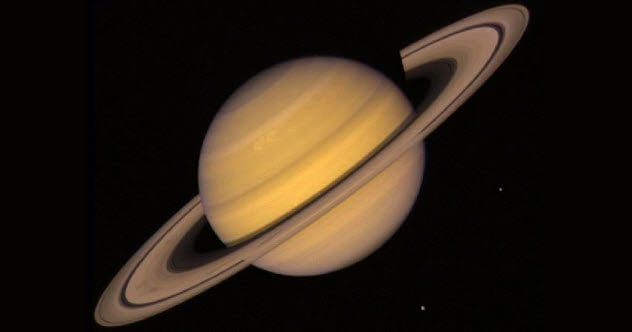Known as the “ringed planet,” Saturn is famous for its stunning ring system and is the most recognizable planet in our solar system. Did you know that its rings appear to vanish every 14 to 15 years from our perspective? That’s just a taste of Saturn’s many quirks. Let’s explore ten amazing facts about this majestic gaseous giant.
10. How and Why the Romans Named Saturn, Saturn
The ancient Romans, observing the seven dominant celestial lights, named them after their gods. Saturn, honored for teaching agriculture and ruling time, also lent its name to Saturday, or Saturn’s Day. The Romans revered Saturn, holding Saturnalia, a festival where normally forbidden activities were tolerated, like gambling with nuts, to honor the Golden Age of Saturn.
9. You Couldn’t Stand on Saturn Even if You Wanted To
Saturn is a ball of churning liquids and gases, primarily hydrogen and helium; therefore, there’s no solid surface to land on. Although the atmosphere wouldn’t pose a problem for a spacecraft, standing on the rings is equally impossible. They consist of billions of ice and rock particles, ranging from sand grains to skyscraper-sized chunks. Earth outweighs Saturn’s rings by 200,000 times! Saturn does have a rocky core, but it’s hotter than the sun’s surface at 15,000°F (8,315°C).
8. How Old Are Saturn’s Rings?
Contrary to earlier beliefs, scientists now believe Saturn’s rings are only about 100 million years old, based on data from the Cassini mission. This is a significant departure from the previous estimate of 4.5 billion years. The rings’ material is too clean; after billions of years, they would have accumulated too much dirt to be visible from Earth.
The current theory suggests that a disrupted moon, forced too close by Titan’s gravitational influence, was torn apart into the particles that form the rings. You can even see Saturn with the naked eye after sunset, and the rings are visible with a 25x to 40x telescope.
7. One Year on Saturn Is 30 Earth Years Long
A year on Saturn, or one complete orbit around the sun, takes 29.4 Earth years. Imagine celebrating your 70th birthday on Saturn; you’d be 2,058 Earth years old! Saturn’s distance from the sun, ten times farther than Earth, and its slower pace through space contribute to this lengthy orbit.
Some theorize that the rings create a magnetic field that exerts a bipolar force, causing drag similar to aircraft. Coupled with the 1.4 billion-mile journey around the sun, Saturn’s years are exceptionally long.
6. Saturn Is Really, Really Big
Saturn is ginormous; over 700 Earths could fit inside it. Though second to Jupiter in size, Saturn boasts a diameter of 72,364 miles (116,460 kilometers). Its rings are believed to be debris from celestial collisions drawn into its orbit by intense gravitational pull.
They comprise billions of particles, from sand grains to mountain-sized rocks, coated with dust. If you could stand on Saturn’s clouds, the rings would appear snowy white, rotating in different directions—a spectacular sight!
5. Saturn Is a Ginormous Solar Radio
The Cassini spacecraft monitored high-energy radio emissions from Saturn, linked to auroras similar to Earth’s Northern and Southern Lights. In April 2002, Cassini detected these emissions from 234 million miles (374 million kilometers) away, displaying fluctuating frequencies.
Launched in 1997, Cassini studied Saturn for nearly 20 years, enhancing our understanding of this enigmatic planet. It studied the rings, moons, and launched the Cassini-Huygens probe, sending back a wealth of scientific data.
4. Saturn’s Moon Enceladus Works Like a Giant Can of Spray Paint
Enceladus, Saturn’s sixth-largest moon, is the most reflective object in our solar system. Geological resurfacing, driven by Saturn’s gravitational pull, results in constant showers of ice and snow.
This tidal action creates heat and geysers that refresh the surface. Discovered in 1789, detailed knowledge of Enceladus came from Cassini’s flybys in 2005. The probe captured geysers venting vaporized water into space near the south pole. Some of this water falls back as snow, while some “spray paints” passing objects, freezing instantly.
3. Titan, Saturn’s Largest Moon, Is Bigger Than a Planet
Titan, larger than Mercury, has a nitrogen-rich atmosphere like Earth. Scientists speculate about rivers, lakes, clouds, and oceans of liquid hydrocarbons like ethane and methane. The Cassini-Huygens probe revealed a rocky, barren surface, but deep methane seas are believed to exist.
Scientists also theorize an ocean of water beneath Titan’s crust could potentially sustain life. The moon’s hazy methane atmosphere necessitated the probe’s landing to provide surface images.
2. Saturn’s Amazing Ring System
Saturn’s rings stretch 175,000 miles (282,000 kilometers) with an average thickness of just 98 feet (30 meters). Designated by letters in order of discovery, they include the dense and easily visible A, B, and C rings, and the fainter D, E, F, and G rings. A 2,920-mile (4,699-kilometer) gap, the Cassini Division, separates the A and B rings. Further out lies the Phoebe ring, trailing behind the moon in its orbit.
1. Saturn’s North Pole Is a 6-Sided Hexagonal Monster Storm
Saturn’s north pole features a hexagonal storm, a perplexing atmospheric phenomenon discovered by the Voyager missions in 1977. This vortex, twice the size of Earth’s hurricanes, is 2,200 miles (3,500 kilometers) across with winds up to 300 miles (482 kilometers) per hour.
Saturn’s winds can reach 1,118 miles per hour (1,800km/h), nearly five times faster than Earth’s highest recorded wind speed. With no solid surface and such incredible rotational speed and winds, staying put on Saturn would be quite the challenge!
From its iconic rings and mysterious moons to its colossal storms and surprising composition, Saturn continues to fascinate and challenge our understanding of the cosmos. Which fact surprised you the most?
Leave your comment below and share your thoughts!










